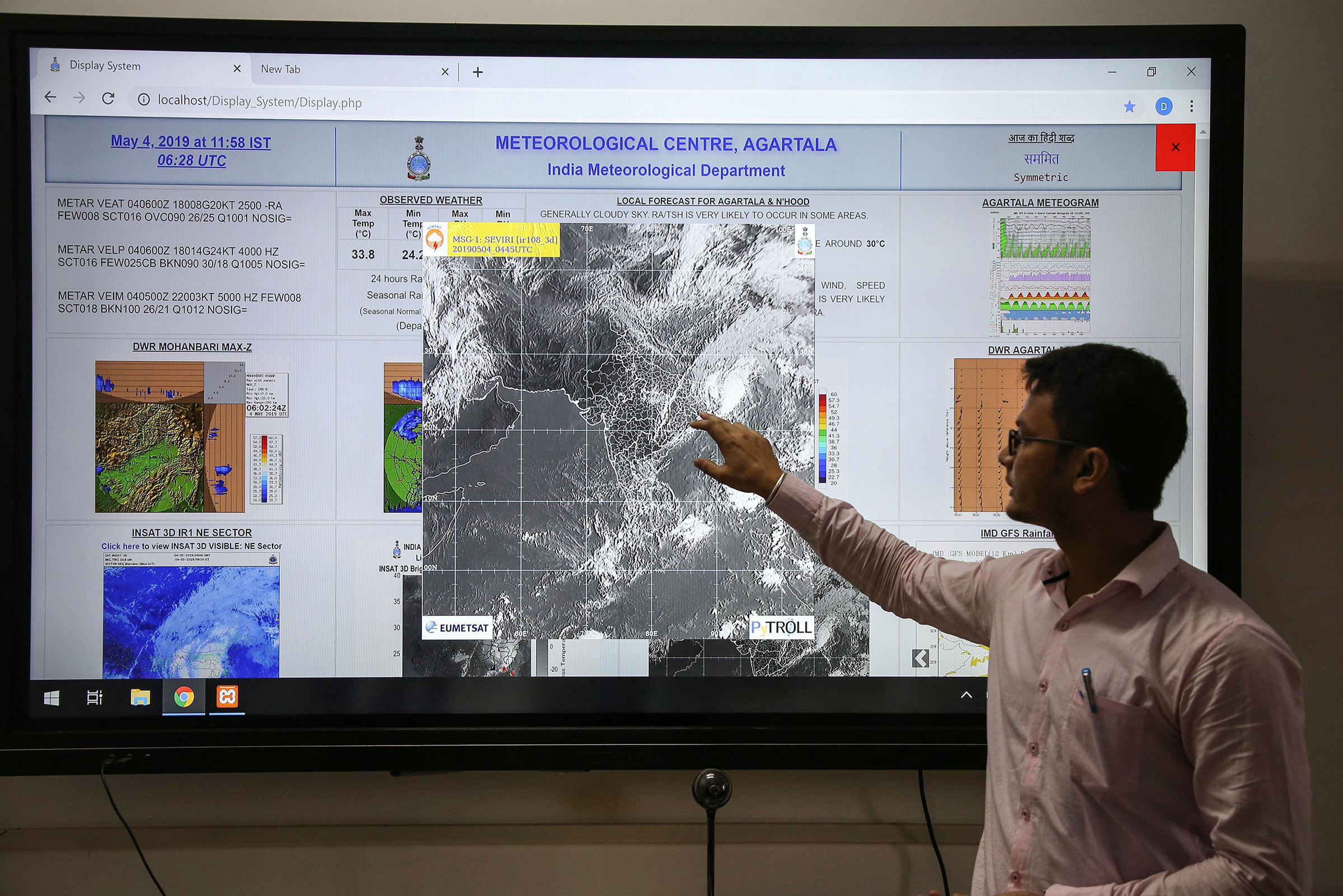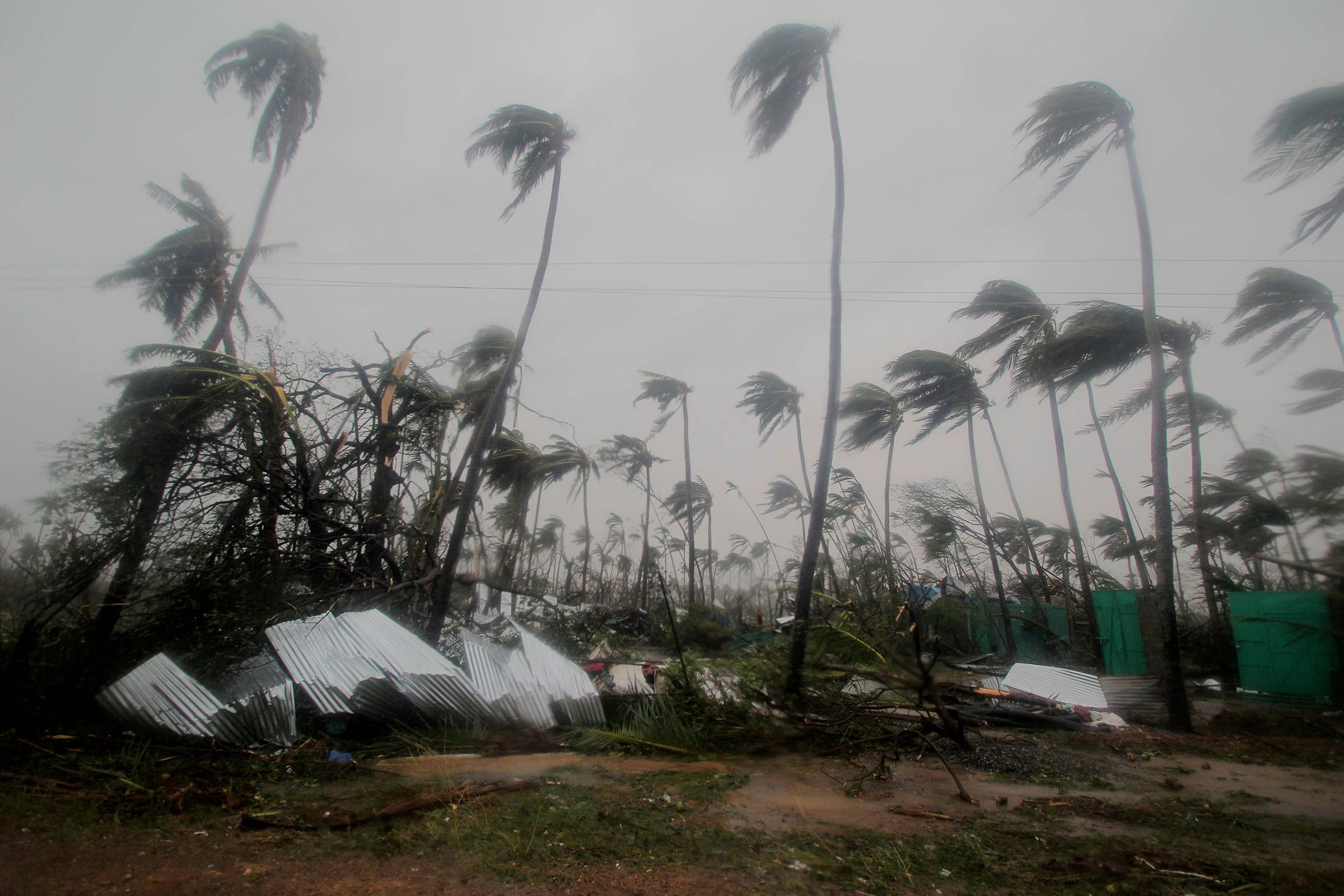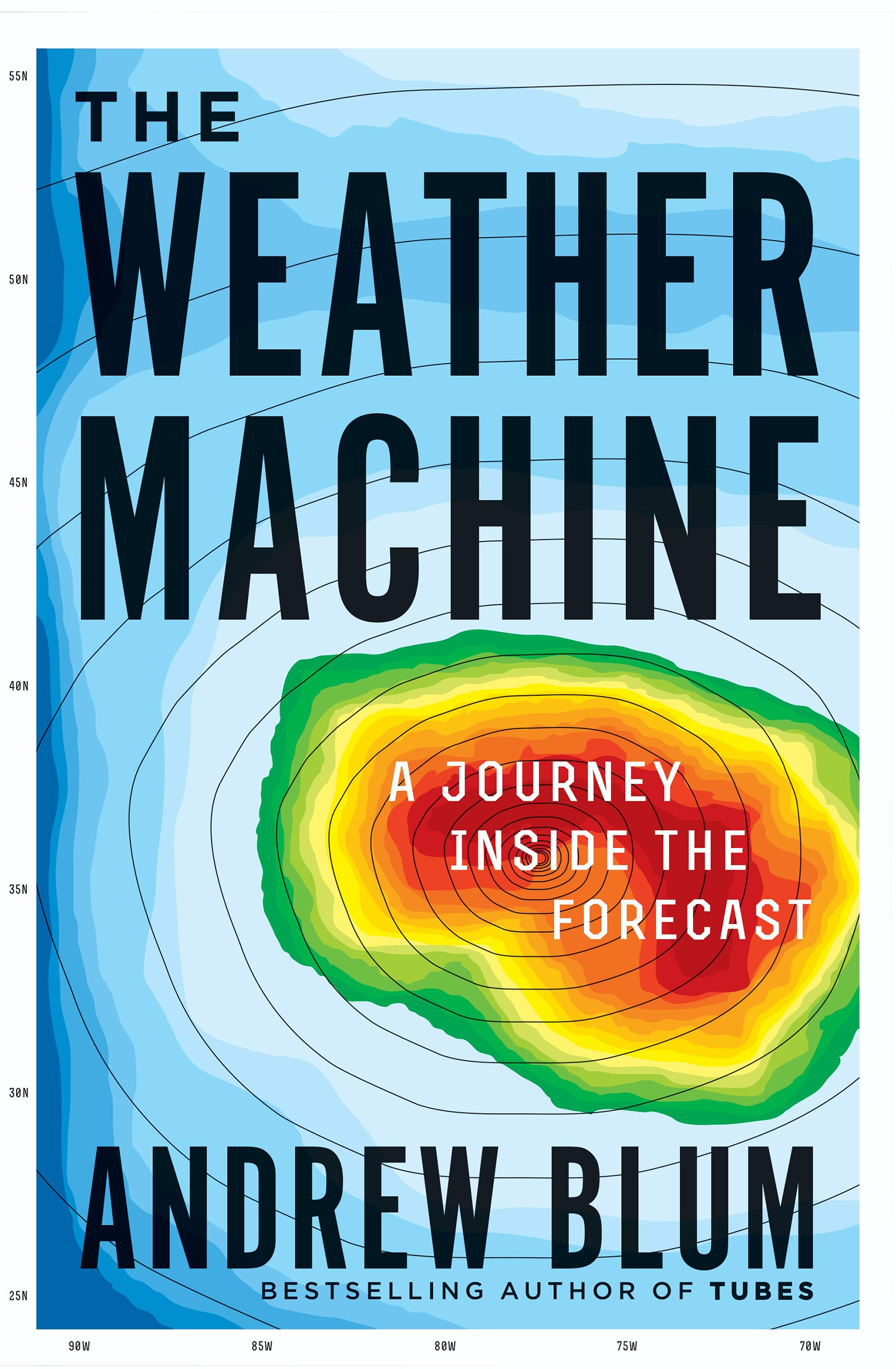
Paul Sauer spins his head like a hawk, standing on the roof of the Marine Air Terminal at La Guardia Airport, as jets whine and fume on the tarmac below. “Pretty straightforward today,” he shouts. “A little stratocumulus to the north. A little bit of middle clouds, which is still moving through us to the south. And a little bit of cirrus above that.” He turns on his heels and heads back down to his office, one floor below. “The machine is not going to see that,” he says. “The machine–well, we’ll find out.”
Out on the runway, near the edge of taxiway DD, “the machine”–a ceilometer–sits on a small patch of grass, burnt to brown by jet exhaust. It measures cloud cover, but only directly above the airport. Even if the thickest fog bank were rolling in from the west, over Manhattan, the ceilometer wouldn’t register it until it arrived. That’s where Sauer comes in. La Guardia is one of 135 airports around the U.S. with a human weather observer, there to back up a suite of instruments known as an Automated Surface Observing System, or ASOS. Sauer watches the weather, and he watches these machines that watch the weather. Once each hour–more often, in poor conditions–he runs up to the roof, looks at the sky and then checks what he sees against what the machines have registered. With a few keystrokes at an old terminal, he changes the numbers. Rather than a single layer of scattered clouds at 8,000 ft., he sees three. “I did not accept the output from the automated system because it was not completely accurate,” he says. “I backed up the sky.”

La Guardia’s human eyes are more the exception than the rule–a fail-safe for the airport’s 83,000 daily passengers. The sensors on the runway are the headwaters of a rushing river of automatically collected data. The observations they collect join tens of millions of others, from satellites and radars, buoys and instrumented balloons, anemometers and thermometers alongside highways and protruding from the fuselages of airliners. They flow through a purpose-built telecommunications system and pool together at designated centers on each continent, where they are processed into forecasts and analyses, and then sprayed back out to the world–to government weather services, morning radio hosts, airline dispatchers, military generals and the smartphone in your pocket.
This torrent of weather data is the result of a deliberate global collaboration dating back 150 years, energized by President John F. Kennedy and optimized only recently with advancements in satellites and supercomputers. It is one of the grand technological achievements of our age, an integrated system of systems–a coherent weather machine.
Today’s weather forecast is a wonder we treat as a banality, a triumph of ingenuity and diplomacy we shrug off with an emoji. Its success at predicting the weather–and improving that prediction year by year–is astonishing. Meteorologists use the word skill to judge the accuracy of their predictions, and it has a specific definition: the measure of their ability to forecast the weather better than climatology, meaning the historical average for the place and date. If the average high temperature in New York on March 1 is 45°F, any forecast has to be right more often than those climatological averages to count as “skillful.” Generally speaking, with each passing decade, meteorologists have been able to make that claim one day further into the future. That means a six-day forecast today is as good as a five-day forecast was a decade ago; a five-day forecast today is as good as a three-day forecast two decades ago; and today’s six-day forecast is as good as a three-day forecast in the 1980s.
But its future is uncertain. In early June, representatives from 193 states and territories gathered in Geneva, as they do every four years, for the congress of the World Meteorological Organization (WMO), a specialized agency of the U.N. They were there to affirm the long-standing terms of this collaboration and work out new ones. In the era of Trump and Brexit, cloud computing and climate extremes, the stakes for the weather forecast have never been higher.
Our ability to see the future of the atmosphere now depends less on the day-to-day insights of any human and more on the year-by-year advancements in computer simulations. These weather models run on supercomputers operated by the elite of the world’s government weather offices, but they serve everyone. “One of the great strengths of the WMO is that we work together as a community to bring the whole community along,” says Sue Barrell, former vice president of the WMO Commission for Basic Systems and the recently retired chief scientist of Australia’s Bureau of Meteorology. “That’s how come we’ve got to the global modeling state that we have now.”
Countries around the world reap the benefits. Before Cyclone Fani struck India in May, authorities had enough warning–and faith in the forecast–to move a million people out of its path. (A similar storm in 1999 killed more than 10,000.) A near record-breaking barrage of tornadoes in the U.S. this spring was met with remarkably accurate predictions, both in the days leading up to likely outbreaks and in the minutes before a tornado actually formed. Even when two massive EF4 tornadoes buzzed through heavily populated areas in Ohio and Kansas, good warnings (and good luck) prevented all but one death. (A large tornado in Joplin, Mo., in 2011 killed 161 people.)
Today’s scientific success–combined with new extreme weather that strikes more frequently–has brought heightened commercial interest. The forecast works better and matters more–to insurance companies preparing for disasters, wind-farm owners optimizing their turbines, airlines eager to save fuel, farmers planting crops or retailers marshaling stock. “The weather enterprise,” as meteorologists call the private sector, sees opportunity. What remains to be seen is if they will further improve the forecast for everyone, or create a two-tiered system of those who can pay for better predictions and those who cannot.

On an afternoon this spring, Neil Jacobs, acting administrator of the National Oceanic and Atmospheric Administration (NOAA)–the agency responsible for observing and predicting the weather–lays out his concerns in an office overlooking the Ellipse, just outside the White House. Fifteen or 20 years ago, Jacobs explains, the role of private companies was exclusively what’s known as “value add”: they would take the observations and forecasts produced by the National Weather Service and tailor or repackage them for specific customers, like airlines or power companies. But today, in what some scientists describe as the new “weather regime” of climate change, the stakes are higher–and the forecasting capabilities greater. “Now you’ve got companies running their own models, deploying their own observing systems,” says Jacobs.
Spire, a San Francisco–founded startup, is selling the weather observations it collects from a fleet of over a hundred tiny satellites. ClimaCell, another startup, based in Boulder, Colo., Boston and Tel Aviv, has begun extracting proprietary weather data from new sources, like cellular transmission signals, and feeding them into its own forecasting system. “If everything is sensitive to weather, we can turn everything into a weather sensor,” says Shimon Elkabetz, ClimaCell’s co-founder. Earlier this year, IBM–which purchased the Weather Company, formerly the Weather Channel, in 2016–announced its own global weather model capable of bringing precise storm forecasting to parts of the world, like Africa and South America, that before had to make do with more general predictions. It will be aided by 80 million observations a day already collected from barometers in smartphones (yes, they’re in there). Each company is banking on potential customers’ seeing their weather observations and forecasts not as a common good but as a commodity, capable of giving them an edge over the freely available government outlooks. The market sees money to be made in reducing the forecast’s uncertainty and responding proactively to extreme events–or just a rainy weekend. Economic damage from severe weather reached $306 billion in 2017. And a NOAA report last year estimated that weather-related variables had swung the nation’s GDP by 3.4%.
“There’s a big disparity there,” Jacobs points out. “That’s just prime opportunity for somebody to close that gap.” He adds, “We’re sort of at this paradigm shift right now, where private industry is there–they’re capable. Now we have to figure out how to harness what they’re doing, while not simultaneously negatively impacting their business model.”
His concern for the needs of industry tracks with the Trump Administration’s interest in prioritizing the role of the private sector in weather forecasts. Before joining NOAA in 2018, Jacobs worked in the weather-forecasting division of Panasonic, the electronics company, developing a proprietary weather model. He is only NOAA’s acting administrator. The man nominated to replace him, Barry Myers, has been a lightning rod for critics. In his former role as the CEO of AccuWeather, Myers argued for new limits on what weather information the National Weather Service could release, leaving companies like his own with more control over the forecast, and greater profits. His appointment awaits a vote in the Senate.
The Trump Administration would apply its industry-first approach to the entire international meteorological community. This spring, Louis Uccellini, the longtime director of the National Weather Service, campaigned for the presidency of the WMO–a move perceived by WMO members as not only a bid for American influence but a threat to the current government-operated system that covers the whole planet and serves the whole planet. Uccellini lost, to the director of the German weather service, Gerhard Adrian, a victory that prompted the Twitter account of the German Mission to Geneva to declare “#MultilateralismMatters.”
“From the very beginning of WMO–and this started in 1873–it was always that if you would like to participate in this system, you would provide your data free and unrestricted, and without any financial benefit,” says Tillmann Mohr, a special adviser to the WMO and former director of the German weather service and the European meteorological satellite agency. The entire global forecasting apparatus depends on this free exchange of data. The nightmare scenario is if that exchange stopped–if, for example, the U.S. stopped sharing the satellite data it acquired from a commercial company. “If every nation took a position that we’re going to have to buy all this stuff in the private sector multiple times over–because that’s essentially what the private sector would like–that would be the end of WMO,” says David Grimes, the outgoing WMO president and director of Canada’s weather service. The impact on the forecast would be felt immediately. “It would take three days before the United States would realize that they couldn’t live in a vacuum,” Grimes says.
But NOAA’s Jacobs worries that if the WMO doesn’t make it easier for private companies to profitably sell their data, they will view the public sector as a competitor rather than a customer. If that happens, proprietary weather models will benefit while public models will be left behind. “There’s nothing preventing them from going to these commercial observing system data providers and offering them an exclusive not to sell the data to government agencies,” Jacobs says. “Then you find yourself in a scenario where the best forecast on the planet is actually for purchase, and you’re separating the haves and have-nots when it comes to life and property.”
From the perspective of many in the WMO, this would itself be a major setback–or at least the ceding of their long-held goal. “We have what we call a ‘public-good mandate,'” says Grimes. “We’re trying to get people out of harm’s way.” Private weather companies “look at the same data but through a different lens,” he adds. “Their perspective is: This is a commodity. This is something that can be monetized.” Jacobs’ concern for the profitability of private weather companies, Grimes says, “might be a made-in-America point of view.”
Key leaders in the private sector remain eager to work within the existing system of collaboration and shared data. “There is an evolution that continues to take place in the global weather enterprise,” says Kevin Petty, director of science and forecast operations and public-private partnerships at IBM’s Weather Company. “But at the same time, I want to reiterate the importance of what our national meteorological services around the world do and that kind of traditional flow of data. We shouldn’t, all of a sudden, run away from the way we’ve always done that.”
It would jeopardize the weather forecast when it’s needed more than ever. If the existing exchange of global data stopped, everyone’s forecasts would suffer. If the skill of private forecasts exceeded public ones, knowing the weather first would become a luxury–giving those willing to pay a head start on evacuating ahead of a storm or preparing for its impacts.
But must public forecasts suffer for private forecasts to succeed? Or can advancements in the private sector benefit public forecasts as well? The remarkable thing about meteorology is how long it has hewed to its origins as a global public good. The challenge for this new era–of both weather and technology–will be to use innovation to improve the system technically without degrading it socially. “There’s a social injustice with extreme events,” says Grimes. “They attack the most vulnerable. Governments, no matter where they are, feel the obligation to step up. They have a social responsibility to care for their people.”

In a speech to the U.N. in September 1961, President Kennedy used the aspiration of global weather observation to redirect Cold War tensions away from a missile race and toward more productive scientific endeavors. “Today, every inhabitant of this planet must contemplate the day when this planet may no longer be habitable,” he said. But weather could be a realm of “cooperative efforts between all nations.” The threat today is climatic–not nuclear. But Kennedy saw that we live on a planet carved up by borders yet encased in a borderless atmosphere. We still do.
Adapted from The Weather Machine: A Journey Inside the Forecast by Andrew Blum. Reprinted with permission Ecco/HarperCollins Publishers.
More Must-Reads From TIME
- The 100 Most Influential People of 2024
- Coco Gauff Is Playing for Herself Now
- Scenes From Pro-Palestinian Encampments Across U.S. Universities
- 6 Compliments That Land Every Time
- If You're Dating Right Now , You're Brave: Column
- The AI That Could Heal a Divided Internet
- Fallout Is a Brilliant Model for the Future of Video Game Adaptations
- Want Weekly Recs on What to Watch, Read, and More? Sign Up for Worth Your Time
Contact us at letters@time.com